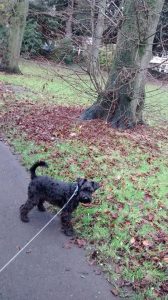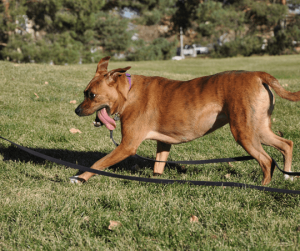Retractable Leads – Do’s and Don’ts.
Many Holidays4Dogs clients and carers will probably use retractable leads at some point while exercising their dogs. However, while these types of leads can have their uses, I have to admit I’m not a huge fan – particularly when used in the extended setting while walking dogs along pavements. Read on to find out more.
Only the other day, as I was reversing out of my drive, a lady was passing by on the other side of the road. Because of this, I was extra careful. I decided to stop and wait – mid-reverse – until the woman was safely past the back of my car. The problem was, I didn’t see that she had a Bichon Frise on the end of a retractable lead. It was lucky I stopped the car, because almost immediately, the little dog darted behind the wheels!
An accident waiting to happen.
The lady was shocked, as her little dog suddenly skipped sideways into the road. She obviously deemed the incident to be entirely my fault, because she glowered at me as she continued on her way. The little dog was, by now, twelve feet ahead of her on the pavement. This is very dangerous and many accidents have occurred with dogs wandering into the road.
I remember once having a brief wrangle with my husband’s aunt who would insist on walking her dachshund around a busy town on a retractable lead. Her little dog – already a significant trip hazard – weaved in and out of people on the end of a 10-foot invisible wire. Indeed, at a distance, it isn’t always easy to see whether the dog is on an extendable lead.
Safety and etiquette.
 When dogs are walked on such long leads it also makes it very difficult for other dog walkers to pass by. If you own a reactive dog – as I do – this has the potential to cause conflict and a great deal of potential tangling.
When dogs are walked on such long leads it also makes it very difficult for other dog walkers to pass by. If you own a reactive dog – as I do – this has the potential to cause conflict and a great deal of potential tangling.
Not everyone appreciates being approached by other dogs, even if they are on a very long lead. If the dog in question is unfriendly, for instance, the presence of such a long cord can complicate any encounters, especially when passing other, less sociable, dogs.
I have also heard of large dogs running to the end of these long leads so fast – the owner is unable to keep hold of the handle. Catching hold of the line can then be impossible. On top of this, the large plastic handle bouncing around adds to the confusion and can frighten dogs into running away.
Locking mechanisms on these devices have been known to fail, so they must be checked regularly.
There is a bit of skill to using extendable leads and most definitely a code of etiquette. There is certainly a place for these sorts of leads. However, they should be kept locked short in busy areas and only used for dogs to roam further in open spaces.
Don’t stop training.
Try not to rely too heavily on a retractable lead to control your dog. Instead, teach your dog recall skills and basic obedience. Avoid hauling your dog back to your side as if he were a salmon on a fishing line! Despite their length, these leads don’t give the dog the proper freedom and free running he needs.
Most mornings I drive across common land near to my house. Frequently, I see an elderly chap with one arm up in the air, holding an extendable lead. He rotates like a spinning top, while his terrier dog races round and round at an incredible rate of knots.
I drive across common land near to my house. Frequently, I see an elderly chap with one arm up in the air, holding an extendable lead. He rotates like a spinning top, while his terrier dog races round and round at an incredible rate of knots.
While very comical to see, this isn’t excellent exercise for the dog or human. I’m sure the little dog and his owner would benefit from a little less spinning and more walking. Makes me dizzy just watching them.
In addition, extending leads are often made of cord, or nylon. Therefore, they are not ideal for puppies who are likely to chew their lead.
A good alternative to retractable leads are long lines. Usually, these dog leads are made from strong webbing. This means they can be used to good advantage, when it comes to training your dog to recall.
With this in mind, Holidays4Dogs has put together a Do’s and Don’t list to promote appropriate and safe use of extendable leads;
Retractable leads – Good manners and safe use;
DO –
Make sure you check retractable leads frequently for signs of malfunction because they can snap, or break.
Train your dog in basic obedience skills and recall. Avoid relying on an extendable lead to manage your dog and to get him back.
Remember – not everyone will want your dog to approach them. When passing other walkers, keep the mechanism locked on the shortest setting.
Buy the best quality extendable lead you can afford. Those constructed with a webbing lead are preferable to the ones made with a cord.
Use these leads in farmland or woodlands, especially with dogs that tend to chase wildlife or livestock. Again, keep them on the short-locked setting when livestock are visible.
Use retractable leads – and long lines – with a harness, rather than a collar.
DON’T –
Use retractable leads on dogs that tend to be reactive, or aggressive. Things can happen quickly and before you have had time to operate the locking mechanism.
Let the lead become tangled around a person’s legs, (or another dog). This is very hazardous and has the potential for conflict – (with dogs and other dog owners).
Expect to stop your dog from pulling on this type of lead. They can encourage the behaviour of forging ahead and wandering off. Therefore, it may not be the best choice, if you have a large breed of dog liable to pull you off your feet.
Allow your dog to wander too far in public places and always be aware of what your dog is doing.
Use these leads on the extended setting anywhere near public highways. Your dog could step into the path of a car, or dart into the road. This can happen, long before you have a chance to reel your dog in, or grapple with the lock.
Conclusion.
Remember, if you have difficulty controlling your dog in general, retractable leads are going to be unsuitable. There are so many things that can go wrong.
Do try to be vigilant and be aware of your and your dog’s surroundings. If your dog pulls, runs away, or is aggressive, putting him on a twelve-foot bungee will not solve the problem. Find a good dog trainer who will be able to help you train your dog to walk nicely on a lead.
holidays4dogs.co.uk and 4Dogs are participants in the Amazon Services LLC Associates Program, an affiliate advertising program designed to provide a means for sites to earn commission fees by advertising and linking to the following websites. Read our full disclosure agreement here.



